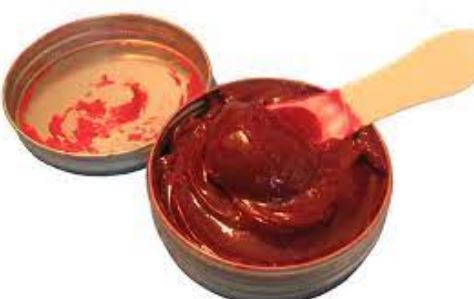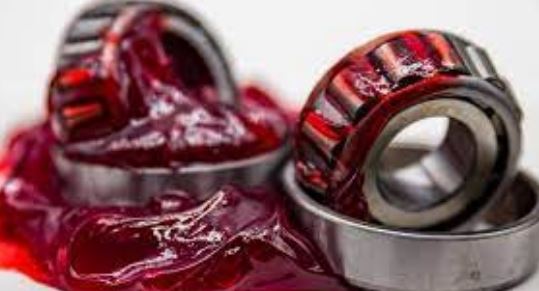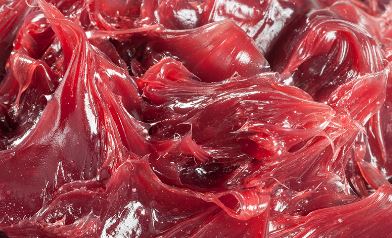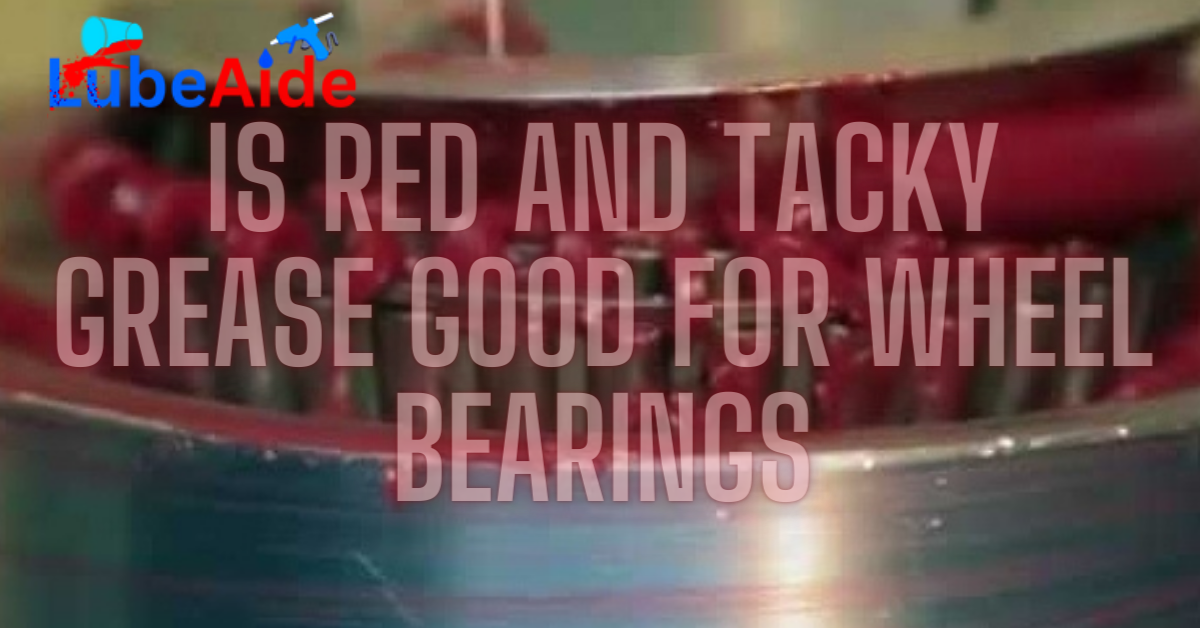One of the critical components of any vehicle or machinery with wheels is the wheel bearings. These bearings are responsible for reducing friction between the wheel and the axle, allowing the wheels to spin smoothly. To keep them in good condition, it is important to lubricate them regularly with the right type of grease. However, with so many different types of grease available, it can be challenging to know which one to use.
In particular, there has been some controversy over the use of red and tacky grease for wheel bearings. In this, we will explore the topic of “Is red and tacky grease good for wheel bearings”, examining the pros and cons of using this type of grease and discussing the factors to consider when selecting the right grease for your wheel bearings.
What Is Red Grease

Red grease is a type of lubricating grease that is characterized by its distinctive red color. This type of grease is commonly used in heavy-duty industrial applications where high-temperature and high-pressure conditions are present. Red grease is typically made from a combination of base oil, thickeners, and additives that give it the desired properties.
The base oil used in red grease can vary, but it is typically a mineral oil or a synthetic oil. Mineral oils are derived from crude oil and are widely used in lubrication applications due to their excellent lubricating properties and low cost. Synthetic oils, on the other hand, are chemically engineered to provide superior performance under extreme conditions.
The thickeners used in red grease are typically either lithium or calcium-based. Lithium-based thickeners are the most common and are preferred for their excellent resistance to water and high-temperature performance. Calcium-based thickeners are less common but offer better performance in extreme-pressure applications.
Additives are added to red grease to enhance its performance and provide additional benefits. Common additives used in red grease include antioxidants, corrosion inhibitors, and extreme pressure additives. Antioxidants are added to prevent the oxidation of the base oil, which can lead to the formation of harmful byproducts. Corrosion inhibitors help protect metal surfaces from corrosion and rust. Extreme-pressure additives are used to prevent metal-to-metal contact under high-pressure conditions.
Red grease is commonly used in a variety of applications, including automotive, marine, and industrial applications. It is particularly well-suited for heavy-duty applications where high temperatures and pressures are present. Red grease can provide excellent protection against wear and corrosion, which can help extend the life of equipment and machinery.
The Pros of Using Red Grease for Wheel Bearings

- High-temperature performance: Red grease is designed to withstand high temperatures, making it ideal for use in wheel bearings that can become very hot during operation. This helps to prevent the grease from breaking down or becoming less effective, which can lead to bearing failure.
- Water resistance: Red grease is also highly resistant to water, which is important for wheel bearings that may be exposed to moisture. This helps to prevent rust and corrosion from developing, which can damage the bearing and reduce its lifespan.
- Longevity: Red grease is typically formulated to provide long-lasting lubrication, which can help to extend the lifespan of the wheel bearings. This can reduce the need for frequent maintenance or replacement of the bearings, which can save time and money in the long run.
- Compatibility: Red grease is generally compatible with most types of metals and plastics used in automotive applications, which makes it a versatile choice for lubricating wheel bearings in a wide range of vehicles.
The Cons of Using Red Grease for Wheel Bearings
- Incompatibility with other types of grease: One of the primary drawbacks of using red grease is that it is incompatible with other types of grease. This means that if you apply red grease to a wheel bearing that was previously lubricated with a different type of grease, the two greases may mix and cause a chemical reaction. This reaction can lead to the formation of harmful acids that can damage the wheel bearing over time.
- High cost: Red grease is more expensive than other types of grease, which can make it less practical for some users. This high cost may be due to the advanced technology used in its formulation, which allows it to withstand high temperatures and resist water washout.
- Staining: Red grease is highly visible and can leave stains on clothing or other surfaces it comes into contact with. This can be problematic for those working with the grease, as it can be difficult to remove.
- Limited shelf life: Red grease has a relatively short shelf life compared to other types of grease. This means that it may not be as effective if it is stored for an extended period before use.
- Difficulty of removal: Red grease can be difficult to remove once it has been applied to a surface. This can be a problem if you need to remove the grease from a wheel bearing or other part of your vehicle.
How Red Grease Affects Wheel Bearings

Red grease is a type of high-temperature grease that is commonly used in automotive applications, particularly for lubricating wheel bearings. Wheel bearings are critical components of a vehicle’s suspension system that allow the wheels to spin freely and smoothly while supporting the weight of the vehicle.
Red grease is typically formulated with high-quality base oils and additives that provide superior lubrication and protection against heat, moisture, and wear. When properly applied, it can help to extend the life of wheel bearings and reduce the risk of costly repairs.
One of the primary ways in which red grease affects wheel bearings is by providing a layer of lubrication between the bearing surfaces. As the wheels spin, friction between the bearing components can generate a significant amount of heat, which can cause the metal to expand and potentially seize up. Red grease helps to minimize this friction, reducing heat buildup and allowing the bearings to operate more efficiently.
Red grease is designed to resist moisture and prevent rust and corrosion from forming on the bearing surfaces. Moisture can be particularly damaging to wheel bearings, as it can cause them to become pitted and worn over time. By keeping the bearings properly lubricated and protected, red grease can help to prevent these types of issues and extend the life of the bearings.
Choosing the Right Grease for Wheel Bearings

- Compatibility: Make sure the grease you select is compatible with the type of wheel bearings in your car. There are different types of wheel bearings, including ball bearings and roller bearings, and each requires a specific type of grease. Check the manufacturer’s recommendations to ensure that the grease you choose is compatible with your vehicle.
- Temperature range: The temperature range of grease is another crucial factor to consider. Wheel bearings can get very hot, especially during long drives or in high-temperature environments. Ensure that the grease you select has a wide temperature range to ensure optimal performance in all conditions.
- Water resistance: Another important consideration is water resistance. Wheel bearings are often exposed to water and moisture, which can wash away the grease, leaving the bearings dry and prone to wear. Choose a grease that is water-resistant to protect the bearings from corrosion and damage.
- Consistency: The consistency of the grease is also crucial. Wheel-bearing grease needs to be thick enough to stay in place and provide adequate lubrication but not so thick that it hinders the rotation of the wheel. The National Lubricating Grease Institute (NLGI) has established a classification system based on the consistency of the grease, ranging from 000 (very fluid) to 6 (very stiff). Consult your vehicle’s manual or the manufacturer’s recommendations to determine the appropriate NLGI grade for your wheel bearings.
Is Red and Tacky Grease Good for Wheel Bearings: Best Practices for Applying
Applying red grease to wheel bearings is an important maintenance task that can help ensure the proper functioning and longevity of your vehicle’s wheels. However, it’s important to follow best practices when doing so to avoid damaging the bearings or other components. Here are some key tips for applying red grease to wheel bearings:
- Clean the bearings: Before applying red grease, it’s important to thoroughly clean the wheel bearings to remove any dirt, debris, or old grease that may have accumulated. You can use a solvent or degreaser to do this, but be sure to follow any safety precautions and allow the bearings to dry completely before proceeding.
- Apply the grease evenly: When applying red grease to the bearings, be sure to do so evenly and avoid applying too much or too little. A good rule of thumb is to fill about half of the bearing cavity with grease, as this will allow for proper lubrication without causing excess heat buildup.
- Use the right type of grease: Not all types of grease are suitable for use on wheel bearings, so be sure to use a high-quality red grease that is specifically designed for this purpose. Look for a grease that meets or exceeds industry standards, such as NLGI Grade 2.
- Don’t mix different types of grease: Mixing different types of grease can lead to compatibility issues and may cause the grease to break down or become less effective. Stick to using one type of red grease for all of your wheel bearings.
- Reassemble the components carefully: After applying the red grease, be sure to reassemble the wheel bearings carefully and according to the manufacturer’s specifications. This may involve torquing the axle nut to a specific value, using a torque wrench to tighten the wheel bearings to the correct setting, or other steps as required.
Alternatives to Red Grease for Wheel Bearings
- Synthetic grease: Synthetic grease is a high-performance lubricant that offers excellent protection against wear and tear, high-temperature resistance, and water resistance. It’s a great alternative to red grease because it’s less likely to break down over time, resulting in longer-lasting protection for your wheel bearings.
- Lithium-based grease: Lithium-based grease is a versatile lubricant that can be used for a variety of applications, including wheel bearings. It’s known for its excellent resistance to water and high-temperature performance. Lithium-based grease is also less expensive than synthetic grease, making it an attractive alternative for those on a budget.
- Ceramic grease: Ceramic grease is a newer type of lubricant that offers superior protection against wear and tear, high-temperature resistance, and water resistance. It’s made with tiny ceramic particles that help to reduce friction and wear on the wheel bearings. Ceramic grease is a bit more expensive than synthetic and lithium-based greases, but its superior performance can be worth the investment.
- Teflon-based grease: Teflon-based grease is a unique lubricant that offers excellent resistance to friction and wear. It’s ideal for wheel bearings that are subjected to high temperatures and heavy loads. Teflon-based grease is also known for its excellent water resistance, making it a great option for vehicles that are exposed to wet or humid conditions.
When selecting an alternative to red grease for your wheel bearings, it’s essential to choose a lubricant that is compatible with your vehicle and the conditions in which you’ll be driving. Consult your owner’s manual or a trusted mechanic for recommendations on the best lubricant for your vehicle’s wheel bearings.
FAQs About Is Red and Tacky Grease for Wheel Bearings
Can red and tacky grease be used in all types of wheel bearings?
No, not all types of wheel bearings are compatible with red and tacky grease. It is essential to check the manufacturer’s recommendations before applying any grease to your wheel bearings.
Is red and tacky grease more expensive than other types of grease?
The cost of red and tacky grease can vary depending on the brand and quantity. However, it is not necessarily more expensive than other types of grease.
How often should I grease my wheel bearings?
The frequency of greasing your wheel bearings can vary depending on the manufacturer’s recommendations and how frequently you use your vehicle or machinery. Generally, it is recommended to grease your wheel bearings every 10,000 miles or once a year, whichever comes first.
Can I mix different types of grease?
Mixing different types of grease can be problematic, as it can cause the grease to break down or become less effective. It is generally recommended to stick to one type of grease and avoid mixing them.
Can I apply too much grease to my wheel bearings?
Yes, applying too much grease can be as problematic as not applying enough. Over-greasing can cause the grease to become too hot and thin, reducing its lubricating properties and potentially causing damage to the wheel bearings. It is important to follow the manufacturer’s recommendations for how much grease to apply.
Final Thought
In the end, the question of is red and tacky grease good for wheel bearings, is a complex one. While this type of grease offers many advantages, such as superior lubrication, high-temperature resistance, and long-lasting protection, there are also potential drawbacks to consider, such as the potential to attract contaminants and difficulty in removing from surfaces.
It’s essential to choose the right grease for your specific application and vehicle or machinery, taking into account factors such as compatibility, temperature range, and load-carrying capacity. Furthermore, proper application techniques and maintenance practices are crucial to ensure optimal performance and extend the lifespan of your wheel bearings.
Related Topic:
- When to Use White Lithium Grease on Rubber Bushings
- How To Remove Grease From Hands And Nails
- Where to Put Dielectric Grease on Spark Plugs
- What Happens If You Don’t Grease Brake Pads
- Why Does Grease Gun Leak: Troubleshooting Guide
- Different Types of Grease
- How to Depressurize a Grease Gun for Storage
- how to get air out of a grease gun
- How to Store a Grease Gun
- Can You Use Dielectric Grease on Brake Caliper Pins
- White Lithium Grease vs WD-40


